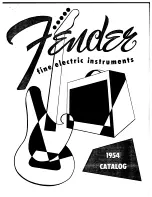
Intonation Adjustments
All six strings can be adjusted forward and backward to set perfect intonation for your playing style.
Intonation Quick Tips
• The action should be at the desired height before intonation begins.
• The neck relief should be correct for the playing style before intonation begins.
• New strings should be installed before intonating. Old strings will not be accurate and are one of the main
causes of poor intonation and tuning.
• Moving the saddle piece forward (toward the neck) will sharpen the note at the 12th fret.
• Moving the saddle piece backward (away from the neck) will flatten the note at the 12th fret.
Each saddle piece has a small Allen head at its end for intonation adjustments
(Fig 4,
size .050 Allen wrench).
This allows the saddle piece to shift forward and backward.
To flatten the note at the 12th fret: Tune the string down slightly
and move the saddle piece back by simply turning the intonation
set screw clockwise using a .050 Allen wrench. To sharpen the
note at the 12th fret: Turn the intonation set screw counter-
clockwise and tap the piece forward lightly with something like
the plastic end of a screwdriver.
Note: The saddle pieces are held in place from the underside of the bridge by
nylon-tipped locking screws that push up on them. (Fig 5)
These screws do not need to be loosened to move the saddles.
If for some reason a saddle slides loose when the strings are
removed, or it begins to buzz while in play, you can easily
retighten the locking screw that secures each saddle with a
1/16 Allen wrench. You do not have to remove the bridge to do this.
If you remove the back cover plate to expose the underside of the
bridge
(Fig 2,3)
you will see the six small holes to access the saddle
locking screws on the inside back plate. Turn the screws clockwise
to snug them up.
Note:
You will need to remove the anchor nut from the treble side to access the
high E string saddle locking screw.
Taylor Guitars
• 1980 Gillespie Way • El Cajon, CA 92020-1096 • (800) 943-6782 • (619) 258-3797 fax • www.taylorguitars.com
FIGURE 4 - Intonation Set Screws
FIGURE 5 - Nylon-Tipped Locking Screw
For additional information, contact the Taylor Guitars
Customer Service Department at (800) 943-6782.






















